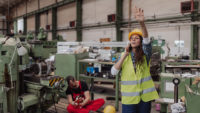There is a growing talent gap between skilled jobs in the trades and trained workers to fill them. In 2011, the Manpower Talent Shortage Survey listed the skilled trades as the most difficult jobs to fill, with electricians, welders, machinists, and carpenters/joiners in highest demand.2
According to the Manpower survey, these are the top 10 most difficult positions to fill:
1. Skilled Trades
2. Engineers
3. IT Staff
4. Sales Representatives
5. Accounting & Finance Staff
6. Drivers
7. Mechanics
8. Nurses
9. Machinist/Machine Operators
10. Teachers
Why the shortage?
The availability of technical training in the skilled trades has significantly declined over the past few decades. Fewer high schools offer vocational or technical programs due to low demand. Kids just aren’t interested in becoming plumbers, electricians and machinists anymore. The manufacturing industry continues to battle an image problem with respect to jobs. There’s a perception that a lot of manufacturing jobs end up overseas. Those jobs that don’t go overseas are considered low-wage, blue collar, factory-type jobs and are often undesirable. Because our schools (and probably parents to some extent) continue to steer youth away from the skilled trades, a four-year college degree remains the preferred career path for most high school students. Making the problem even worse, demographics are changing too, as skilled baby boomers are entering retirement. Workers in mid-career or those who have been laid off and are looking for work may not be adequately trained to program today’s more sophisticated factory equipment.
There’s pride in the trades
It takes a special person to be able to learn and understand the complex and technical nature of most skilled trades. To be a plumber, electrician, carpenter, mechanic or machinist requires attention to detail, sheer smarts and hard work. These are honorable professions that don’t deserve the negative stigma that seems to persist. Wages for electricians and plumbers are respectable too. The average salary for a plumber, according to a current salary report on Indeed.com is $42,000. For an electrician it’s $47,000. A journeyman machinist can earn up to $49,000. And if the number of jobs for these skills continues to outpace available candidates, you can expect these averages to go up. If you choose to work as an apprentice, you can start earning a living right away as you learn your trade.
We need people with skills
Maybe we should start with a PR campaign in every high school in the United States promoting the skilled trades. Companies who rely on these skills should invest in actively recruiting at the high-school level and in vocational schools and community colleges with kids enrolled in these programs. Let’s face it. College isn’t for everyone, and it’s expensive. According to ConsumersReport.org, the average college graduate has over $22,000 in college loan debt. But it can easily climb higher depending on your choice of college and degree. This is not to say that a college education is a bad choice; instead, it’s a reminder that there are other options. If we don’t start preparing more people with these skills, we’re going to face a lot of challenges ahead. The U.S. infrastructure—aviation, roads, bridges, dams, drinking water, energy supply, railroads, mass transit, schools, parks and recreation, and so forth—all of this needs skilled workers to maintain it. These jobs will not go overseas. In manufacturing, today’s automated factories need workers who can not only operate computerized equipment, but can also program and maintain it. Many of those looking for work need more skills training to fill the growing number of these manufacturing jobs.
Hard work is good
In addition to the economy, our high unemployment rate can also be attributed to our talent supply. There are clearly jobs available, but not enough skilled workers to fill them. This talent gap will continue to grow if we don’t do anything about it. We can start by working to change the stigma attached to the skilled trades and hard work. Getting your hands dirty isn’t a bad thing. Mike Rowe, host of the TLC show “Dirty Jobs” and champion for skilled workers in the United States, is dedicated to reinvigorating the image of the skilled trades. His mission statement: “Work is not the Enemy” is the theme to his website, mikeroweWORKS.com, a community dedicated to skilled labor.
What can you do?
The next time someone suggests to you that a career in manufacturing or a skilled trade is a bad choice, challenge them. Hard work and skill is honorable, and the U.S. needs more people who have the aptitude, ability and willingness to work in these respected fields. Today’s manufacturing jobs are not simply dirty, dangerous, low-wage jobs. Manufacturing equipment has become much more sophisticated. People filling these jobs have to know how to operate highly technical equipment. They have to know how to cut steel with lasers, water jets and plasma cutters. They have to program robots how to paint, package and palletize products. These types of jobs require computer programming and other high-tech skills, which seems to be what younger people look for in today’s job market.3
Article by W.W. Grainger
Sources:
1. Deloitte 2011 Skills Gap Report for Manufacturing Institute
2. Manpower International, May 2012 Talent Shortage Survey
3. Rochester Business Journal, July 6, 2012




